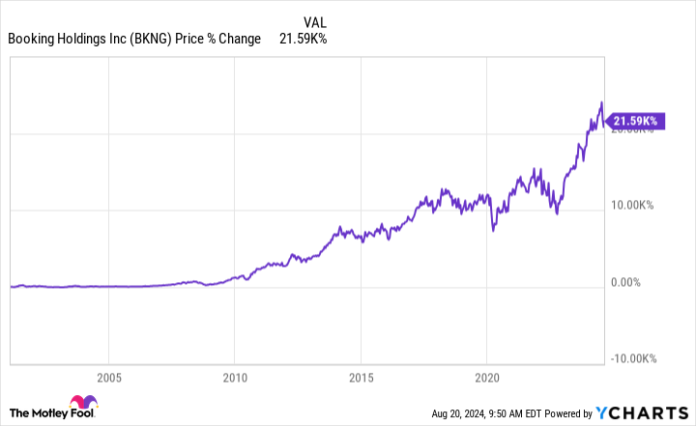Holding a inventory over years of non-performance could also be one of the vital troublesome components of investing.
Energetic inventory buyers will inevitably make unsuitable selections about their shares at instances. This consists of probably the most broadly revered buyers, equivalent to Warren Buffett, who has outlined a number of investing errors in his shareholder letters over time.
Nonetheless, selecting a inventory that loses practically all its worth will not be the one kind of mistake and even the most costly. As an alternative, the biggest errors can occur from promoting too early. This occurred to me with Reserving Holdings (BKNG 1.66%), then often called Priceline.com.
At present, at roughly $3,700 per share as of the time of this writing, it’s the third costliest inventory buying and selling on U.S. markets. Nonetheless, in the course of the dot-com bust, it had reached penny inventory standing on a pre-split foundation, and the inventory’s conduct right now proved to be each a profit and a detriment to my investments.
My Reserving Holdings funding
I’ve watched Reserving Holdings since its March 1999 preliminary public providing (IPO). From a split-adjusted value of $96 per share, it reached a split-adjusted excessive of $990 per share within the dot-com increase. Since I additionally believed on this firm and its enterprise mannequin, I regretted not shopping for.
Nonetheless, the dot-com bust took its toll on the inventory, and by December 2000, it could fall greater than 99% from that top to a split-adjusted low of simply over $6 per share.
As a result of ache of my different dot-com bust losses on the time, I used to be not fast to behave. Nonetheless, once I noticed it rise to a split-adjusted $18 per share, I believed I had discovered a discount with a constructive catalyst and purchased 166 shares at that value (1,000 shares at $3 per share pre-split) in early 2001.
By the summer time of that 12 months, Reserving (née Priceline) had risen to an adjusted $48 per share, and I centered on value motion as an alternative of fundamentals. I had practically tripled my funding in a short while and determined to lock in my good points by promoting the complete place.
Reserving Holdings after I offered
Admittedly, the occasions of the subsequent few years appeared to substantiate the “correctness” of my determination.
One occasion that made me really feel vindicated was the inventory’s 1-for-6 reverse inventory break up in 2003. Through the dot-com bust, quite a few corporations enacted a reverse break up to get out of penny inventory standing, however in practically each occasion, it delayed somewhat than prevented bankruptcies. Relatively than carry out due diligence, I merely took this as an indication that promoting was the suitable determination.
Furthermore, the inventory value didn’t keep sustainably above $48 per share till 2007. If I had the shares again someday over that 12 months, my snap determination to promote in 2001 wouldn’t have damage me. Nonetheless, 2007 was the 12 months that Reserving inventory lastly started to take off. Even within the depths of the 2008 to 2009 monetary disaster, it remained above my promote value and started to expertise progress resembling its dot-com increase days.
In the long run, if I had held my inventory (or repurchased the shares quickly after), I might maintain shares of Reserving Holdings value roughly $614,000 as of this writing!
Classes from my Reserving Holdings expertise
My expertise with Reserving Holdings reveals the facility of figuring out a high-quality inventory at a low value when the market is in chaos.
Nonetheless, the extra necessary and difficult lesson is the issue of holding such a inventory by its harder instances with the data and self-discipline required to face pat. To maintain Reserving Holdings inventory for a protracted sufficient time, I might have needed to endure six years of holding the inventory with a small achieve and no further progress. Moreover, the reverse inventory break up (a transfer that also doesn’t make sense to me) would have led to additional doubts.
Had I stayed centered on the basics, I may need observed that revenues declined between 2000 and 2003 — however they had been nonetheless far above 1999 ranges.The enterprise mannequin wasn’t good for that troubled period, nevertheless it was already working.
Additionally, when income started rising after 2003, it elevated by double-digit percentages. With the corporate additionally turning worthwhile in 2003, financials pointed to an eventual restoration.
Such due diligence can be important as a result of large stock-price declines are sometimes indicative of a looming chapter. If unsure about an organization’s future, its financials will most probably present indicators of stability once they seem.
After evaluating my very expensive mistake, my recommendation is to remain conscious of an organization’s precise outcomes, prioritizing the basics over the inventory’s conduct. It is just by performing such due diligence that one can inform the distinction between a discount inventory and an organization seemingly headed towards chapter.


